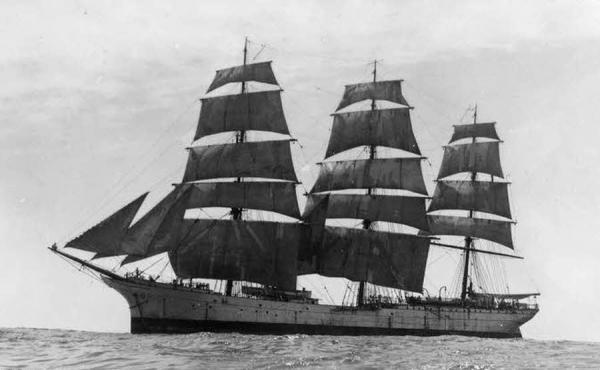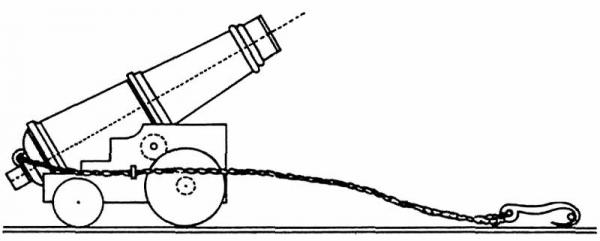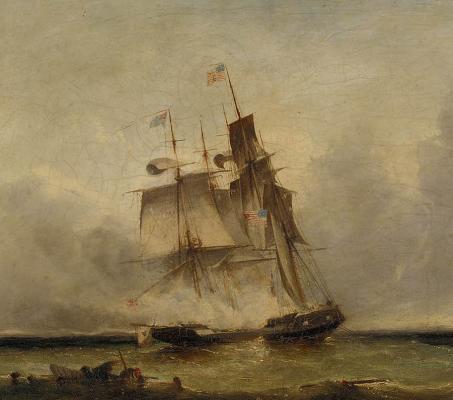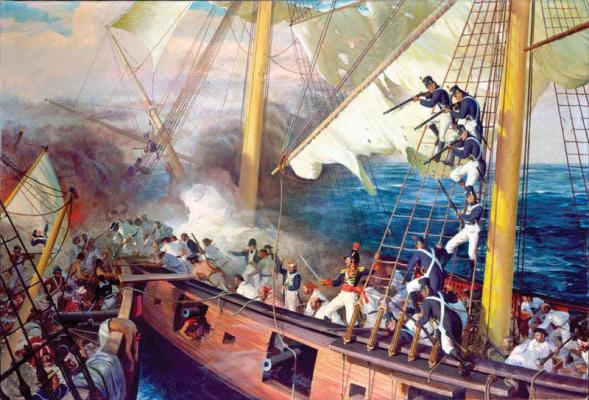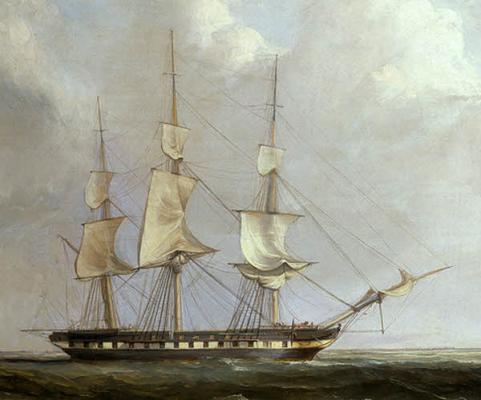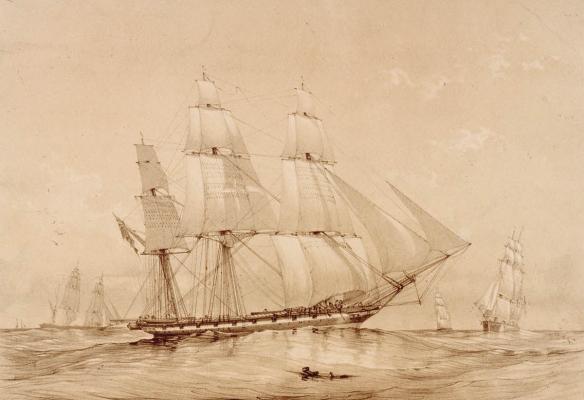-
Posts
455 -
Joined
-
Last visited
Content Type
Profiles
Forums
Gallery
Events
Everything posted by molasses
-
We are still waiting for confirmation of Anja's apparently correct guess. "Rubber Duck" is merely a distraction while we wait.
-

Cruizer-class Brig-Sloops of the Royal Navy
molasses replied to molasses's topic in Nautical/Naval History
Tom: Thank you for your very kind compliments. Your pleasure from reading my narratives makes the effort worthwhile. Michael: Your Rose is beautiful. -
Is it Carleton?
-
Correct, it's how she appeared when she was the Pacific Queen from 1933 to 1954. She was in the 1935 "Mutiny on the Bounty" starring Clark Gable and Charles Laughton. Her appearance today at San Francisco Maritime Museum missing her fore topgallant mast and riding very high in the water. Your turn, Adrieke.
-
-

Cruizer-class Brig-Sloops of the Royal Navy
molasses replied to molasses's topic in Nautical/Naval History
Sounds familiar, just a different medium. As soon as that first piece of wood is cut a compromise has been made because the wood itself isn't to scale. -
Model Expo has the same chain of 42 links per inch. On my Esmeralda build I made eye bolts from 32 gauge (.008 inch/0.2 mm) wire that looked like cotter pins. Substitute whatever wire seems appropriate for hinge, eye and bolt.
- 800 replies
-
- snake
- caldercraft
-
(and 1 more)
Tagged with:
-
Anaurus, 1883. Sold and renamed Mabella in 1905. Sunk by German sub in 1917.
-

Cruizer-class Brig-Sloops of the Royal Navy
molasses replied to molasses's topic in Nautical/Naval History
Howard I. Chapelle's The History of the American Sailing Navy has a hull plan compiled from the NMM drawings and a drawing of Epervier made by William Rule and Henry Peake during her preparation for US service. Chapelle's drawing shows before and after configurations but no spar dimensions. It seems reasonable to me that sail plans or spar take-offs would not be made unless there were significant differences from standard practice such as was done of the topsail schooners built in the Chesapeake Bay area. The practice of the period was to list spar dimensions in the construction contract documents but I haven't done a search for them at NMM. My plan is to work with the Caldercraft Cruizer kit which I assume has spars based on their research or on standard practice. I agree that confirmation would be great. -

Cruizer-class Brig-Sloops of the Royal Navy
molasses replied to molasses's topic in Nautical/Naval History
Thank you, Wayne, very much! You might want to go back to my earlier articles from time to time to see what has been added. This project has grown from a simple internet search for basic information into something more. I've learned a lot from it, not just about the ships and people, but also, more importantly, where and how to look for that information. For example, in an article, "The Carronade," by Spencer C. Tucker in The Nautical Research Journal, Mar. 1997, Vol.42, No. 1, I just today found a drawing of a boat gun like the 12 pounder used on the Cruizers in the War of 1812. This article is well referenced to other sources of more information. Boat gun set for firing at tops, The use of a quoin would allow horizontal fire. As a result, I've come to the conclusion that the 2 x 18 pounders in the forward gun ports on Epervier were not carronades or gunnades (which were a carronade with a different method of mounting the barrel to the slide not used until about 1820), but were much more likely boat guns. They would be a better fit in the restricted space at the forward ports than any carronade. Of course this conjecture needs verification, but good enough for most models except in a museum. Dave -

Cruizer-class Brig-Sloops of the Royal Navy
molasses replied to molasses's topic in Nautical/Naval History
Thank you, Mark, Andy and Dave, for your kind comments. They make the effort to collect and organize the information and then write it up worth while. I'm very pleased that you enjoy my feeble efforts. I went through my previous articles to correct and add information that I learned since I posted them, including those posted on this thread. Thank you to all who posted corrections and additional information. Dave -

Cruizer-class Brig-Sloops of the Royal Navy
molasses replied to molasses's topic in Nautical/Naval History
Cruizers, part 6: HMS Reindeer The Cruizer-class brig-sloop HMS Reindeer launched on 15 August 1804, commissioned in September and set sail for the Jamaica station on 21 November with Commander John Fyffe in command. She was one of six Cruizers built from fir to speed construction and cut cost, a compromise that would significantly reduce their service lives. All six were started and launched within a period of three months from 22 May through 22 August. Raven, the first Cruizer discussed here, was one of that group, wrecked in 1805. Another foundered in 1809. In 1812, two were broken up and a third placed in ordinary and later sold. By 1814, Reindeer was the only one of this group still in service and four years past her projected service life. Under Commander Fyffe’s command on the Jamaica station from May 1804 through February 1807, Reindeer captured at least six enemy privateers and one sunk and participated with Magicienne in the cutting out expedition of a French merchant schooner from under a battery in Aguadilla Bay, Puerto Rico. Reindeer also engaged two French Navy brigs of 16 x 9 pounder guns, sailing together, in a running battle and chase of over four hours until they managed to escape after taking damage from Reindeer’s fire. They were captured two days later by HMS Pique and taken into Royal Navy service. Reindeer, in January, shared with three other Royal Navy men-of-war the proceeds from the capture of an unspecified number of merchant vessels. Commander Peter John Douglas took command in February 1807. Reindeer captured six privateers, three merchant vessels and re-captured an English vessel held by a French prize crew. After a chance meeting of Reindeer and four other Royal Navy vessels on 10 November 1808, the captains decided to capture the town and port of Samana, a base for many French privateers, in support of Spanish patriots attempting to overthrow French rule over the western part of the island of Santo Domingo. After the capture of the town and port (and French vessels sheltered there), Captain Charles Dashwood of Franchise handed Samana over to a Spanish officer, Don Diego de Lira, who guaranteed the safety of the French inhabitants on their plantations. The combined operations of these five ships netted two French privateer schooners and five merchant vessels in the week following the capture of Samana. Reindeer, with Commander Douglas still in command, was in the North Sea for most of 1809 where she captured the French fast dispatch vessel Mouche No.13 on 8 March. On 4 November 1809, Reindeer set sail for Jamaica with Commander Christopher Crackenthorp Askew in command. Reindeer, Commander Nicholas Lechmere Pateshall in command since sometime in 1811 or early 1812, with Polyphemus (64), and Thalia (36) set sail from Jamaica on 20 May 1812 to escort a convoy of about 100 ships bound for The Downs. They also carried news of the declaration of war by the United States, ratified and signed on 18 June, learned on the journey from a passing merchant vessel. A hurricane likely scattered the British convoy but the escorts collected some of the ships and continued to the destination. [The records, as far as I am able to find, are not clear on this except for the departure of the convoy and the sighting near Portsmouth of two of the escorts with a smaller convoy. Polyphemus separated from the convoy soon after it rounded the western tip of Cuba.] The American Commodore, John Rodgers, within an hour of learning on 21 June of the 18 June ratification of the declaration of war, had ordered his squadron to set sail from New York to find and intercept this same convoy. This squadron consisted of Rodger’s flagship President (44), United States (44), Congress (36), Hornet (18) and Argus (16). They did not find the convoy but the President did engage the HMS Belvidera (36) on 23 June for the first naval action of the war. Belvidera did enough damage with her stern chasers - combined with the catastrophic chase gun explosion on the President that caused damage to the foremast, yards, sails and rigging, killed 16 men and wounded Rogers and many crewmen - to slow the President and allow Belvidera’s escape. Reindeer arrived at Plymouth on 1 August 1812 for a refit that lasted until 11 September. It is likely that her 16 x 32 pounder carronades where exchanged for 24 pounders due to her age and having been built from fir although the records I have consulted cannot confirm the exchange during this refit, only that she was armed with them on a later date. It is also possible that the 32s were needed elsewhere and the change had nothing to do with Reindeer‘s condition. [see also post #13, which I had forgotten about, regarding these guns being replaced after Manners threw several 32s overboard during a storm. I gladly defer to uss frolick's expertise on this point.] This would reduce the dead weight on deck by 7,500 pounds and improve her speed and other sailing characteristics. Commander Daniel Ross took command and set sail on the June 12 to begin his duties based from Plymouth. Ross’s successor on Reindeer, Commander William Manners, captured six privateers and merchant vessels in 1813 with the first one on 2 February. They included two American privateer schooners, a French privateer lugger of 14 guns, a French merchant brig and two recaptured British merchant vessels held by unspecified enemy prize crews. Four of these were captured while Reindeer was in company with another British warship. One recapture was made by the Cruiser-class Derwent with assistance from Reindeer on 13 December. Reindeer continued operating out of Plymouth through June of 1814. The new American sloop-of-war Wasp, sister to the previously mentioned Peacock, was commissioned in early 1814 with Master Commandant Johnstone Blakeley in command. She remained at Portsmouth, New Hampshire, until receiving orders to attack British shipping in the western approaches of the English Channel and set sail on 1 May 1814 with a hand picked crew of 173 officers, sailors and marines, passing unobserved through the blockading frigates. USS Wasp’s Specifications Length: 117 ft Beam: 31 ft 6 inches Tonnage: 509 (burthen) Rig: ship-rigged sloop Armament: 20 x 32 pounder carronades + 2 x 12 pounder chase guns Complement: 173 In June, the Wasp, repeating the spectacular successes by Argus of the previous year, captured five British merchant vessels, scuttled four and turned one over to the accumulated prisoners. At 4:15 am of 28 June, about 225 miles west of Plymouth, Wasp began the pursuit of two merchant vessels to the northwest but soon noticed a third bearing down on her from a little north of east. This was the Reindeer with orders to find and destroy the Wasp. Action Between USS Wasp and HMS Reindeer, 28 June 1814 By Edwin Hayes, 1819-1904, NMM Collection Under an overcast sky with a wind from the northeast so light that it scarcely disturbed the unusually smooth surface of the sea, Manners on Reindeer and Blakeley on Wasp began a contest in seamanship over the weather-gage that continued for more than ten hours. By ten am, both ships were identified as enemy sloops with Reindeer maintaining the weather-gage. At about 1:15, with no weather advantage gained or lost, Wasp beat to quarters without shortening sail then at 2:00 fired a gun to windward. Peacock immediately responded in kind to accept the challenge. The maneuvering continued until 3:17 with both vessels close-hauled on the larboard tack running parallel courses at less than 60 yards distance and Reindeer still holding a slight weather advantage off Wasp’s larboard quarter. Reindeer fired the only gun on either sloop that would bear – her 12 pounder carronade boat gun mounted on the topgallant forecastle loaded with round shot and grape. Two minutes later Manners fired again, and again, five times. Seeing that Reindeer was very slowly pulling even with Wasp, Blakely turned to the wind at 3:26 and hauled up his mainsail while firing a rolling broadside from aft forward as each gun bore during the turn. Peacock then turned to as well to bring her starboard battery to bear and fired at a distance of less than twenty yards from Wasp. Both crews, working the guns with desperate energy, exchanged broadside for broadside for ten minutes until Manners realized his only chance for victory lay in boarding and let Reindeer’s head fall off towards her opponent. The sloops ground together at 3:40, men hacked and thrust at each other through the open gun ports while dense smoke from the fire of the guns that still bore billowed up from between the hulls. Cheered on by the mortally wounded Manners, grimly determined British sailors appeared through the smoke onto the deck of Wasp met by the deadly musket fire from her marines in the tops and the cutlasses and pikes of her sailors on deck. Bleeding profusely from a grape shot wound through both thighs and with several other less serious wounds, Reindeer’s captain sprang sword in hand to the foremast shrouds to lead personally his willing crew back onto Wasp saying, “Follow me, my boys, we must board them.” At that moment, a musket ball smashed through his skull and he fell back dead onto Reindeer’s deck, his sword still clenched in his right hand. As Manners fell and his men recoiled at the sight, Blakeley seized the moment to order his men forward onto Reindeer. After a moment’s furious struggle, Wasp’s boarders slew or drove below the remaining defenders. The captain’s clerk, the senior officer alive on deck, surrendered the brig at 3:44, 27 minutes after Reindeer had fired the first gun and 18 after Wasp had responded. Marines Aboard USS Wasp Engage HMS Reindeer By Sergeant John Clymer, USMC, 1945, Collection of the National Museum of the Marine Corp Depicting the moment of Commander Manners’ fall, at far left Reindeer was cut to pieces in line with her ports, and her upper works, boats and spare spars were reduced to splinters. Both masts were badly wounded just above the deck with the foremast tottering. Including her courageous commander and both midshipmen, she had 33 dead or dying and 34 wounded out of her crew of 98 men and 20 boys. The sails and rigging of Wasp were well cut up. Six round shot and many grape were embedded in her hull and many more had penetrated her sides or entered through her gun ports. One 24 pound shot had passed through the center of her foremast. Out of her complement of 173 men, she had 11 dead or dying and 15 wounded. In a comparison between Reindeer and Wasp of the weight of broadsides and the size of the crews, the disparity for each is very close to 2 to 3, the greatest of any of the actions between Cruizer-class brig-sloops and the nominally “equal” American sloops. The outcome was proportional to the difference in force. Roosevelt quoted Cooper, “It is difficult to say which vessel behaved the best in this short but gallant combat.” Roosevelt went on to say, “I doubt if the war produced two better single-ship commanders than Captain Blakeley and Captain Manners; and an equal meed [measure] of praise attaches to both crews.” Even James refrained from his usual defamatory, anti-American remarks, “The action of the Reindeer and Wasp may be pronounced one of the best-fought sloop actions of the war,” although he did resort to his characteristic distortion of the numbers. After Reindeer’s surrender, Master Commandant Johnstone Blakeley and both crews set to work caring for the wounded, burying the dead and making repairs through the night and into the next day, 29 June. When the wind increased during the day, Reindeer’s foremast fell and the decision made to burn her rather than risk her re-capture. After the wounded were transferred to Wasp and a passing neutral vessel, and Reindeer’s 12 pound boat gun brought on board, Reindeer was fired. Wasp stood off to watch her burn and then set a course for L’Orient after her magazine exploded. Three Royal Navy vessels and three US Navy vessels have borne the name “Reindeer” in her honor. As an alternative subject for Caldercraft’s Cruizer, Reindeer would need a change in the armament to 24 pounder carronades (which are available), the addition of the 12 pounder carronade mounted on a gun carriage and the addition of the fore and aft platforms like those on Snake. Because of my research into these Cruizer class brigs, I am becoming convinced that the platforms may have been typical, but more research is needed to confirm this. In the six that I have researched for these articles the platforms were mentioned specifically or their existence implied in the sources. Next: HMS Avon Sources: The Naval History of Great Britain by William James, 1824 History of the Navy of the United States by J. Fenimore Cooper, 1836 The Naval War of 1812 by Theodore Roosevelt, 1900 The Age of Fighting Sail by C. S. Forester, 1957 Dictionary of American Naval Fighting Ships, Dept US Navy, (online) “NMM, vessel ID 374389”, Warship Histories, vol.iii, National Maritime Museum (online) “HMS Reindeer (1804)”, “USS Wasp (1814)”, “Sinking of HMS Reindeer”, articles on Wikipedia (online) The London Gazette, 16 citations listed in “HMS Reindeer (1804)”, Wikipedia [Edited to include information from post #13 I had forgotten to include, also typo corrections] -
I found after posting the image that there were two Owen Glendowers. One was the Blackwall frigate of 1839, which is what I posted. Then I found that there was an HMS Owen Glendower of 1808, but all the images of it on the internet are actually the Blackwall ship as evidenced by the pre-1843 Blackwall company flag of a blue square centered on a red St. George's cross at the main masthead. Your turn St. George.
-
-
SMS Niobe, 1849. Launched as HMS Niobe but not commissioned into the Royal Navy, sold to Prussia in 1862 and used as a training ship. Seven future admirals were among the cadets trained on her: Alfred von Tirpitz, Wilhelm Büchsel, Oscar Klausa, Iwan Oldekop, Otto von Diederichs, Richard Geissler, and Oscar Boeters.
-
Drat, beat me by 2 minutes.
-
HMS Zebra, 1780, 16-gun ship sloop, later changed to 18-gun. Converted to a bomb vessel in 1798. Laid up in ordinary in 1809, sold in 1812. You did a nice re-touch to remove the second ship image to avoid (or maybe cause ) confusion.
-
St. George is correct; HMS Satellite. She had a sister, Acorn. They were also designed by Sir Robert Seppings (remember HMS Spider?) whose signature appears on the drawings for them in the NMM archive. Your turn St. George.
-
Not Constitution.
-
I'm a big fan of C. S. Forester's Hornblower stories and consider them to be far superior to Patrick O'Brian's Aubrey/Maturin series. I found Hornblower to be a much more rounded and believable character with his shyness and personal struggle with his self-perceived shortcomings compared to the two dimensional Jack Aubrey and Stephen Maturin. I thought while reading O'Brian that he could have used elements of those two characters and combined them into one much more three dimensional, and more interesting, protagonist. I don't believe that O'Brian had the ability to do that and developed the two characters to make up for that shortcoming. I thought Stephen Maturin to be a more complete character than the cardboard cut-out that was "Lucky" Jack Aubrey. After reading several of the Aubrey/Maturin novels I found each more formulaic than the preceding. In several, O'Brian takes the reader to the beginning of a sea battle then just skips ahead to the outcome. In others, I got the strong feeling that I had already read that battle even though it was my first reading of that particular book. It seemed to me that O'Brian couldn't come up with very many different ways for battles to proceed. My second reading of the series reinforced these first impressions. Hornblower stories are set in a sound historical context. One of his exploits, his first as a post captain, involves him in a clandestine operation that partially brings about the chain of events leading to Nelson's victory at Trafalgar. He then is given the duty to organize and carry out Nelson's funeral procession on the Thames during which he prevents Nelson's funeral barge from sinking. Later, Hornblower gets caught in a serious dilemma after carrying out orders to secretly sail into the Pacific and aid a megalomaniac rebel overthrow Spanish rule. He captures the one Spanish ship in the region and turns it over to the madman, El Supremo, then learns that during his long voyage to the Pacific, Spain switched sides to become a British ally. He is forced to find and re-capture or destroy that ship. Later in the series, Hornblower is influential in Tsar Alexander I of Russia's decision to resist Napolean's advance into Russia and then assists in the defense against the siege of the city of Riga. The Hornblower stories are so solidly set in an historical context that the fictional "biography" of Hornblower by C. Northcote Parkinson has frequently been taken as the biography of a real Horatio Hornblower. C. S. Forester is also noted as a naval historian, particularly for The Naval War of 1812 (published as The Age of Fighting Sail in the US) and Hunting the Bismarck (adapted for the 1960 film Sink the Bismarck!) as well as his other historical fiction novels. The first six books of the Aubrey/Maturin series covers the entire span of the Napoleonic Wars with reference to historical events in that time period, from 1800 up to 1 June 1813 with specific mention of the Shannon vs Chesapeake. The next twelve novels enter a fantasy period from June to November 1813 with a series of exploits that would require the passage of six or more years to occur. In The Yellow Admiral, the Duke of Wellington's invasion of France from Spain, which occurred in November 1813, is mentioned followed by Aubrey's exploits lasting several months and then the coming of Christmas 1813. The series then returns to an approximate, but distorted, context inside the scope of historical events. Patrick O'Brian readily admitted to these distortions and his creation of a fantasy time to accommodate his stories. I'm not saying I don't enjoy Patrick O'Brian's Aubrey/Maturin novels, particularly the puns and fractured metaphors. I've read the entire series twice, but I found them to be just a substitute for the "real thing" so to speak, of Forester's Hornblower. Kind of like a heroine junkie getting by on methadone. I enjoyed the movie "Master and Commander: The Far Side of the World," but if it was playing opposite "Captain Horatio Hornblower," (from a screenplay written by C. S. Forester) on TV I'd choose Hornblower in a heart beat. Ernest Hemingway has been quoted as saying, "I recommend Forester to everyone literate I know." Winston Churchill stated, "I find Hornblower admirable." I used the Wikipedia articles "Horatio Hornblower" and "Aubrey/Maturin Series" as references for the historical context portion of this monologue to supplement and verify my own memory of the respective series. The two quotes directly above are quoted in the Wikipedia Hornblower article. Edited for typos.
-
No, not Defiance.
-
Not Blackwall.
-
-
That's Portland painted by Willem van der Velde the elder.
-
Congratulations, St. George, Fly is correct. NMM presents contradicting descriptions. It's identified as "Privateer Fly" on the prints they sell, however, the description for the original in the collection states, "The received title of the picture is ' The Privateer "Fly" but it is not clear why this may be the case... Both the flags and armament are consistent with this being a portrait of the Royal Naval cutter 'Fly' of 1779." Your turn, St. George.
About us
Modelshipworld - Advancing Ship Modeling through Research
SSL Secured
Your security is important for us so this Website is SSL-Secured
NRG Mailing Address
Nautical Research Guild
237 South Lincoln Street
Westmont IL, 60559-1917
Model Ship World ® and the MSW logo are Registered Trademarks, and belong to the Nautical Research Guild (United States Patent and Trademark Office: No. 6,929,264 & No. 6,929,274, registered Dec. 20, 2022)
Helpful Links
About the NRG
If you enjoy building ship models that are historically accurate as well as beautiful, then The Nautical Research Guild (NRG) is just right for you.
The Guild is a non-profit educational organization whose mission is to “Advance Ship Modeling Through Research”. We provide support to our members in their efforts to raise the quality of their model ships.
The Nautical Research Guild has published our world-renowned quarterly magazine, The Nautical Research Journal, since 1955. The pages of the Journal are full of articles by accomplished ship modelers who show you how they create those exquisite details on their models, and by maritime historians who show you the correct details to build. The Journal is available in both print and digital editions. Go to the NRG web site (www.thenrg.org) to download a complimentary digital copy of the Journal. The NRG also publishes plan sets, books and compilations of back issues of the Journal and the former Ships in Scale and Model Ship Builder magazines.




